Technoware EVO DSP PLUS TT 100 KVA User manual

Uninterruptible Power Supply
EVO DSP PLUS TT 100 KVA
EVO DSP PLUS TT 120 KVA
EVO DSP PLUS TT 160 KVA
EVO DSP PLUS TT 200 KVA
User’s manual
Manuale utente


Index
User’s Manual - English...............................................................................1
Safety Warnings........................................................................................1
1Introduction........................................................................................2
2General Characteristics ..........................................................................3
3Receipt and site selection .......................................................................3
3.1 Site Selection ................................................................................3
3.2 UPS Unpacking ...............................................................................4
4Operational Principles............................................................................5
4.1Block Diagram of UPS .......................................................................5
4.2 Operation Modes.............................................................................6
4.2.1 Standby Mode .........................................................................................6
4.2.2 Line Mode..............................................................................................7
4.2.3 Battery Mode..........................................................................................7
4.2.4 Bypass Mode ...........................................................................................8
4.2.5 ECO Mode ..............................................................................................8
4.2.6 Shutdown Mode .......................................................................................9
4.2.7 Maintenance Bypass Mode...........................................................................9
5Control Panel and LCD Touchscreen ........................................................ 10
5.1 Introduction ................................................................................ 10
5.2 LCD Touchscreen Description............................................................ 11
5.2.1 Initial Screen ........................................................................................ 11
5.2.2 Main Screen (Home)................................................................................ 11
5.2.3 Control Submenu ................................................................................... 13
5.2.4 Measurement Screen............................................................................... 14
5.2.5 Setup Screen ........................................................................................ 16
5.2.5.1 Setup General Screen ...................................................................... 20
5.2.5.2 Setup System Screen ....................................................................... 23
5.2.5.3 Setup Battery Screen....................................................................... 25
5.2.5.4 Setup Pre-Alarm Screen.................................................................... 26
5.2.5.5 Setup Parallel Screen....................................................................... 27
5.2.6 Information Submenu .............................................................................. 28
5.2.6.1 Information–Identification Submenu ..................................................... 28
5.2.6.2 Information–System Submenu ............................................................. 28
5.2.6.3 Information–Battery Submenu ............................................................ 29
5.2.7 Event Submenu ..................................................................................... 30
5.2.7.1 Event-Current Events Submenu .................................................................. 31
5.2.7.2 Event-History Events Submenu................................................................... 31
5.2.7.3 Event-Reset All Events Submenu................................................................. 32
5.3 Alarm List................................................................................... 33
5.4 History Record ............................................................................. 35

6ELECTRICAL INSTALLATION....................................................................36
6.1 Front Side ................................................................................... 36
6.1.1 Power Stage/Module............................................................................... 36
6.1.2 Interface and Communication.................................................................... 37
6.1.2.1 CN1-Temperature Detection Port for External Battery Pack ........................ 38
6.1.2.2 CN2-EPO (Emergency Power OFF) connector........................................... 38
6.1.2.3 RS232 and USB Interfaces.................................................................. 39
6.1.2.4 SNMP Interface .............................................................................. 39
6.2 Rear Panel .................................................................................. 40
6.3 Output/input Terminal Blocks ........................................................... 41
6.4 Installation.................................................................................. 42
7Functioning.......................................................................................44
7.1 Turn ON Operation ........................................................................ 44
7.2 Cold Start Startup.......................................................................... 46
7.3 Turn OFF Operation ....................................................................... 47
7.3.1 Turn OFF Operation in Bypass Mode/Standby Mode .......................................... 47
7.3.2 Turn OFF Operation in Line Mode................................................................ 49
7.3.3 Turn OFF Operation in Battery Mode............................................................ 50
7.4 Maintenance Bypass (Manual Bypass) Operation ..................................... 50
7.4.1 Transfer to Maintenance Bypass ................................................................. 51
7.4.2 Transfer to UPS Protection ....................................................................... 52
7.5 Low Battery and Automatic Restart..................................................... 53
7.6 Load Control................................................................................ 53
7.7 Operating Procedures for Parallel System ............................................. 54
7.7.1 Input and Output Wiring........................................................................... 54
7.7.2 Parallel Setting ..................................................................................... 55
7.7.2.1 Parallel Board for UPS 1 ................................................................... 55
7.7.2.2 Power Stage/Module ID of UPS 2 ......................................................... 55
7.7.2.3 Parallel Board for UPS 2 ................................................................... 56
7.7.3 Parallel Function Setting.......................................................................... 57
7.7.4 Parallel Cable Connection ........................................................................ 57
7.7.5 Parallel System Turn On Procedure ............................................................. 58
8Technical Characteristics ......................................................................59
9Maintenance......................................................................................61
9.1 UPS Cleaning ............................................................................... 61
9.2 Battery ...................................................................................... 61
9.3 Operator Safety ............................................................................ 61
10 Troubleshooting .................................................................................62
Conformity to the European Directives .........................................................65
Product Disposal .....................................................................................65
Lead Batteries........................................................................................65

Indice
Avvisi di Sicurezza .................................................................................. 67
1Introduzione ..................................................................................... 68
2Caratteristiche Generali ....................................................................... 69
3Ricevimento e Collocazione................................................................... 69
3.1 Scelta della Collocazione................................................................. 69
3.2 Disimballaggio e Posizionamento........................................................ 70
4Principi di Funzionamento .................................................................... 71
4.1 Diagramma a Blocchi dell’UPS........................................................... 71
4.2 Modi di Funzionamento ................................................................... 72
4.2.1 Modo Standby ....................................................................................... 72
4.2.2 Modo Line............................................................................................ 73
4.2.3 Modo Battery........................................................................................ 73
4.2.4 Modo Bypass ......................................................................................... 74
4.2.5 Modo ECO ............................................................................................ 74
4.2.6 Modo Shutdown ..................................................................................... 75
4.2.7 Modo Maintenance Bypass......................................................................... 75
5Pannello di Controllo e Touchscreen LCD .................................................. 76
5.1 Introduzione................................................................................ 76
5.2 Descrizione dell’LCD Touchscreen ...................................................... 77
5.2.1 Schermata Iniziale.................................................................................. 77
5.2.2 Schermata Principale (Home) .................................................................... 77
5.2.3 Sottomenu “Control” .............................................................................. 79
5.2.4 Schermata “Measurement” ....................................................................... 80
5.2.5 Schermata “Setup”................................................................................. 82
5.2.5.1 Schermata “Setup-General”............................................................... 86
5.2.5.2 Schermata “Setup-System”................................................................ 89
5.2.5.3 Schermata “Setup-Battery” ............................................................... 91
5.2.5.4 Schermata “Setup-Pre-Alarm” ............................................................ 92
5.2.5.5 Schermata “Setup-Parallel”............................................................... 93
5.2.6 Sottomenu “Information”......................................................................... 94
5.2.6.1 Sottomenu “Information–Identification” ................................................ 94
5.2.6.2 Sottomenu “Information–System”........................................................ 94
5.2.6.3 Sottomenu “Information-Battery” ....................................................... 95
5.2.7 Sottomenu “Event” ................................................................................ 96
5.2.7.1 Sottomenu “Event-Current Events”...................................................... 97
5.2.7.2 Sottomenu “Event-History Events” ...................................................... 97
5.2.7.3 Sottomenu “Event-Reset All Events” .................................................... 98
5.3 Lista Messaggi di Allarme................................................................. 99
5.4 Altre Segnalazioni nella “History Events”.............................................101

6INSTALLAZIONE ELETTRICA.................................................................. 102
6.1 Lato Frontale ..............................................................................102
6.1.1 Stadi/Moduli di Potenza.......................................................................... 102
6.1.2 Porte di Comunicazione e Interfacce .......................................................... 103
6.1.2.1 CN1-Porta per Rilevamento Temperatura della Batteria Esterna.................. 104
6.1.2.2 CN2–Connettore EPO (Emergency Power Off)......................................... 104
6.1.2.3 Interfacce RS232 e USB ................................................................... 105
6.1.2.4 Interfaccia SNMP ........................................................................... 105
6.2 Retro UPS ..................................................................................106
6.3 Morsettiere Output/Input ...............................................................107
6.4 Installazione Elettrica....................................................................108
7Funzionamento ................................................................................ 110
7.1 Procedura di Accensione.................................................................110
7.2 Accensione Cold Start....................................................................112
7.3 Procedura di Spegnimento ..............................................................113
7.3.1 Spegnimento in Modo Bypass/Modo Standby.................................................. 113
7.3.2 Spegnimento in Modo Line ....................................................................... 115
7.3.3 Spegnimento in Modo Battery ................................................................... 116
7.4 Operazioni di Maintenance Bypass (Bypass Manuale) ...............................116
7.4.1 Trasferimento a Maintenance Bypass .......................................................... 117
7.4.2 Trasferimento a Funzionamento UPS........................................................... 118
7.5 Fine Autonomia e Riaccensione Automatica..........................................119
7.6 Controllo del Carico ......................................................................119
7.7 Procedure Operative per Sistemi Parallelo ...........................................120
7.7.1 Collegamenti Input/Output...................................................................... 120
7.7.2 Impostazioni per Parallelo ....................................................................... 121
7.7.2.1 Scheda Parallelo dell’UPS 1 .............................................................. 121
7.7.2.2 Numero ID degli Stadi/Moduli di Potenza dell’UPS 2................................. 121
7.7.2.3 Scheda Parallelo dell’UPS 2 .............................................................. 122
7.7.3 Impostazioni per il Funzionamento Parallelo ................................................. 123
7.7.4 Collegamento dei Cavi Parallelo................................................................ 123
7.7.5 Procedura Accensione del Sistema Parallelo.................................................. 124
8Caratteristiche Tecniche..................................................................... 125
9Manutenzione.................................................................................. 127
9.1 Pulizia dell’UPS ...........................................................................127
9.2 Batterie ....................................................................................127
9.3 Sicurezza dell’Operatore ................................................................127
10 Anomalie ed Interventi....................................................................... 128
Conformità alle Direttive Europee ............................................................. 131
Smaltimento del Prodotto ....................................................................... 131
Batterie al Piombo ................................................................................ 131

ENGLISH
UPS EVO DSP PLUS TT 1User’s manual
User’s Manual - English
Safety Warnings
Read this manual carefully and completely before installing and using the TECNOWARE EVO
DSP PLUS TT Uninterruptible Power Supply, which, from here after, will also be referred to as
UPS.
The UPS must be used only by properly trained personnel. To ensure correct and safe
operations, it is necessary that operators and maintenance personnel observe the general
safety Standards as well as the specific instructions included in this manual.
Risk of electric shock: do not remove the cover. The UPS contains internal parts which are at
a high Voltage and are potentially dangerous, capable of causing injury or death by electric
shock.
There are no internal parts in the UPS which are user serviceable. Any repair or maintenance
work must be performed exclusively by qualified technical personnel authorized by
TECNOWARE. TECNOWARE declines any responsibility if this warning is disregarded.
The electric installation has to be done by qualified personnel. Follow all the Safety Standards
(CEI Standards in Italy or IEEE elsewhere) for the Input/Output connections and for the right
section of Input/Output cables.
It is compulsory to ground the UPS according to Safety Standards.
Risk of electric shock at the Output lines when the UPS is ON.
Risk of electric shock at the Output lines while the unit is connected to the AC utility line.
For respect of the Safety Standards is necessary the presence of a differential circuit breaker
between UPS Output lines and the loads.
We recommend to use a dedicate AC Input/Output power line for the UPS.
Do not obstruct ventilation slots or holes and do not rest any object on top of the UPS.
Do not insert objects or pour liquids in the ventilation holes.
Install the UPS indoors, in a protected, clean and moisture-free environment.
Do not expose to the direct sun light.
Do not keep liquids, flammable gases or corrosive substances near the UPS.

ENGLISH
User’s manual 2UPS EVO DSP PLUS TT
1Introduction
UPS EVO DSP PLUS TT (UPS means Uninterruptible Power Supply) is the result of constant technological research
aimed at obtaining the best performance at the lowest cost.
UPS EVO DSP PLUS TT is an advanced ON-LINE UPS built specifically to protect your computer from any
irregularities in the AC line (for example blackouts, brownouts, over voltages, micro-interruptions), which often
cause damage to hardware and software.
All that is possible because UPS EVO DSP PLUS TT is a Double-Conversion ON-LINE UPS.
Under normal AC line condition UPS EVO DSP PLUS TT provides an automatic Output Voltage regulation from the
Rectifier and Inverter blocks and filters out frequently occurring electrical disturbances (high Voltage transients,
spikes, interferences, etc.), thus protecting the devices connected to its outlets. During a power failure, UPS EVO
DSP PLUS TT continues supplying adequate AC power (with a true sine wave) to all connected devices through
batteries and by its DC/AC converter (Inverter).
UPS EVO DSP PLUS TT protects the devices from accidental overload or Inverter fault by an Automatic Bypass that
directly connects the AC Input line with Output LIne.
UPS EVO DSP PLUS TT models are factory-equipped with RS-232 and USB interfaces, which may be used for notify
to a computer a power failure or a Low Battery condition: this allows automatic data backup during an extended
blackout with the most common operating systems (Windows, Linux, Unix, etc.). Thanks to Interfaces, UPS EVO
DSP PLUS TT can communicate the several made measurements (Input/Output Voltage, batteries, absorption,
Frequency, etc.), and can also be programmed in order to start-up or shutdown automatically at fixed times.
Read this manual carefully before using the UPS EVO DSP PLUS TT; it includes
important safety warnings and useful advices for correct use and installation.
UPS EVO DSP PLUS TT is constantly being developed and improved: consequently, your unit may differ somewhat
from the description contained in this manual.
This manual includes the following models:
UPS EVO DSP PLUS TT 100 KVA
UPS EVO DSP PLUS TT 120 KVA
UPS EVO DSP PLUS TT 160 KVA
UPS EVO DSP PLUS TT 200 KVA
In this manual UPS EVO DSP PLUS TT will simply be referred to as UPS.
EVO DSP PLUS TT models are made from a single unit that contains only the electronic parts. There are not
batteries inside the unit.
Then the UPS must be connected to an external Battery Box to operate properly.

ENGLISH
UPS EVO DSP PLUS TT 3User’s manual
2General Characteristics
UPS EVO DSP PLUS TT has all the advanced features, which guarantee maximum reliability and safety:
Double-Conversion ON-LINE Transformerless technology
Power stages/modules architecture (from 3 to 6 power stages/modules in a single UPS)
Output Voltage regulation 1%
Protection from overload and short circuits
Automatic Bypass to protect from accidental overload or Inverter fault
Start-up even under Mains OFF conditions
Automatic protection when Battery is low
Automatic restart, following an automatic shut-down due to Low Battery, once AC utility power comes
back on
Selectable Input Frequency (50/60 Hz)
Touchscreen Graphic LCD for monitoring of the Input and Output Voltages measurements, batteries
Voltage, percentage of load, frequency, alarms, overload, fault, events history and path of energy flow
and for setting all the UPS parameters
Acoustic signals of various kinds indicating alarm situations
SNMP Adapter (optional)
EPO (Emergency Power OFF)
Communication with the computer through RS-232 and USB interfaces
Available extended autonomy by adding external Battery Boxes
Manual Bypass for maintenance
Parallel operating mode up to 2 UPS (optional)
ECO functioning Mode (selectable)
Frequency Converter functioning mode (selectable)
High efficiency
Maximum reliability
Smart design and easy to use
3Receipt and site selection
3.1 Site Selection
We recommend paying attention to the below points in order to choose a correct placement for your UPS:
The UPS is designed to operate in a protected environment (e.g. offices). We therefore recommend
installing it in a place with very little or no humidity, dust or smoke.
When the UPS is brought from a cold place to a warmer place, humidity in the air may cause
condensation in the UPS. In this case, allow UPS to stand for two hours in the warmer place before
beginning with the installation.

ENGLISH
User’s manual 4UPS EVO DSP PLUS TT
In all circumstances, see the “Technical Characteristics”chapter for environmental specifications and
check that the selected area meets these criteria.
During normal operation the UPS discharges a minimal amount of heat. So it is necessary to leave at least
30 cm of unobstructed space all around the UPS in order to keep it properly ventilated.
Do not obstruct ventilation holes.
Do not insert objects or pour liquids in the ventilation holes.
Do not rest any object on top of the UPS.
Do not keep liquids, flammable gases or corrosive substances near the unit.
Install the UPS on a properly tiled floor. Avoid the installation on a floor that is not tiled flat.
3.2 UPS Unpacking
Carefully remove the UPS from its packaging, and carry out a meticulous inspection.
We recommend keeping the original packaging in a secure place, in case you need to send the UPS for
maintenance purposes. In case of transport damage, notify the carrier and dealer immediately.
We advise you to follow the steps below explained:
1. Use a forklift to move the product to installed
area. Please make sure the bearing capacity
of forklift is sufficient.
2. Please follow the unpacking order to remove
carton (and )and foams (and ).

ENGLISH
UPS EVO DSP PLUS TT 5User’s manual
3. Remove two fixing plates (, and )
located on the two sides of the unit. Loosen
levelling feet ( ) in figure by rotating
them in counter clockwise. Then, move the
cabinet from the pallet.
4. To fix the cabinet in position, simply rotate
levelling feet clockwise.
4Operational Principles
4.1 Block Diagram of UPS
Figure 4.1 –Block and Wiring Diagram

ENGLISH
User’s manual 6UPS EVO DSP PLUS TT
4.2 Operation Modes
EVO DSP PLUS TT is a Three-Phase, Four-Wire On-Line, Double-Conversion UPS that permits operation in the
following modes:
Standby Mode
Line Mode
Battery Mode
Bypass Mode
ECO Mode
Shutdown Mode
Maintenance Bypass Mode (Manual Bypass)
4.2.1 Standby Mode
Upon connecting to Utility Input Power, the UPS is in Standby Mode unless UPS is turned on (if Bypass enable
setting is Disabled), and Charger Function will be active when the Battery is connected. The load is not powered
under this mode.
Figure 4.2 –Standby Mode Diagram

ENGLISH
UPS EVO DSP PLUS TT 7User’s manual
4.2.2 Line Mode
In Line Mode, the Rectifier delivers power from the mains and supplies DC power to the Inverter and the Charger
charges the Battery. The Inverter filters the DC power and converts it into pure and stable AC power to the load.
Figure 4.3 –Line Mode Diagram
4.2.3 Battery Mode
The UPS automatically transfers to Battery Mode if the Utility fails. There is no interruption to the load upon
failure. In battery mode, the rectifier delivers power from the battery and supplies DC power to the inverter.
The inverter filters the DC power and converts it into pure and stable AC power to the load.
Figure 4.4 –Battery Mode Diagram

ENGLISH
User’s manual 8UPS EVO DSP PLUS TT
4.2.4 Bypass Mode
Upon connecting to Utility Input Power, the UPS is in Bypass Mode before UPS is turned on (if BYPASS enable
setting is Enabled), and Charger function will be active when Battery is connected.
After UPS has been turned on, if the UPS encounters abnormal situations (over-temperature, overload …, etc.),
the Static Transfer Switch (STS) will perform as a transference of the load from the Inverter to the Bypass source
with no interruption. If the transference is caused by a recoverable reason, the UPS will turn back to Line Mode
when abnormal situation has been solved.
Figure 4.5 –Bypass Mode Diagram
4.2.5 ECO Mode
The ECO Mode can be enabled through the LCD control panel. In ECO mode, the load is diverted to Bypass when
the Bypass voltage and frequency are within the acceptable ranges. If the Bypass is out of range, the UPS will
transfer the power source of load from Bypass to Inverter. In order to shorten the transfer time, the rectifier and
inverter are working when the UPS is in ECO mode.
Figure 4.6 –ECO Mode Diagram

ENGLISH
UPS EVO DSP PLUS TT 9User’s manual
4.2.6 Shutdown Mode
When you want to switch off the UPS and the power supply is absent, the UPS will enter Shutdown mode. Or
when the UPS has discharged the Battery to the cut-off level, the UPS will also enter into Shutdown Mode.
When the UPS enters this mode, it is going to shut off the control power of UPS. The Rectifier, Charger and
Inverter will be all shutdown.
Figure 4.7 –Shutdown Mode Diagram
4.2.7 Maintenance Bypass Mode
A Manual Bypass Switch is available to ensure continuity of supply to the critical load when the UPS becomes
unavailable e.g. during a maintenance procedure. Before entering the Maintenance Bypass Mode, make sure the
Bypass power source is normal.
Figure 4.8 –Maintenance Bypass Mode Diagram

ENGLISH
User’s manual 10 UPS EVO DSP PLUS TT
5Control Panel and LCD Touchscreen
5.1 Introduction
On the front panel of the UPS there is the control interface which is divided into 3 parts: (1) LCD Touchscreen,
(2) LED indications, (3) Power ON/OFF button, as shown in figure 5.1. All the electrical measurements,
parameters, settings, UPS status, battery status and any alarms are displayed on the LCD Touchscreen.
In addition, the UPS emits, during operation, acoustic signals through a buzzer (refer to table 5.3).
Figure 5.1 –Control Panel
(1) LCD Touchscreen
(2) LED indications (refer to table 5-1)
(3) Power ON/OFF Button (refer to table 5-2)
Table 5-1: LED Indications
LED
Color
Status
Definition
LINE
Green
ON
Input source is normal.
Flashing
Input source is abnormal.
OFF
No input source
BYPASS
Yellow
ON
Load on Bypass.
Flashing
Input source is abnormal.
OFF
Bypass not operating.
LOAD
Green
ON
There is power output for the load.
OFF
There is no power output for the load.
INV
Green
ON
Load on inverters.
OFF
Inverters not operating.
BATTERY
Red
ON
Load on Battery.
Flashing
Low battery
OFF
Battery converter is normal and battery is charging.
FAULT/ALARM
Red
ON
UPS fault.
Flashing
UPS alarm.
OFF
Normal.

ENGLISH
UPS EVO DSP PLUS TT 11 User’s manual
Table 5-2: Power Button
Control Key
Description
Power ON/OFF
Turn On UPS or Turn Off UPS (hold 2 seconds).
Table 5-3: Audible Alarm
UPS condition
Description
Power ON/OFF
Buzzer sounds 2 seconds.
Battery mode
Buzzer sounds every 2 seconds.
Low Battery
Buzzer sounds every 0.5 seconds.
UPS alarm
Buzzer sounds every 1 second.
UPS fault
Buzzer continuously sounds.
5.2 LCD Touchscreen Description
5.2.1 Initial Screen
Upon powering on, the UPS will execute POST (Power-On Self-Test). The initial screen will remain approximately
5 seconds as shown below.
Figure 5.2 –Initial Screen
5.2.2 Main Screen (Home)
After initialization, the main screen will display as shown in figure 5.3. Main Screen is divided into six sections.

ENGLISH
User’s manual 12 UPS EVO DSP PLUS TT
Figure 5.3 –Main Screen
(1) Operation Mode: it shows UPS current operation mode and status.
(2) Flow Chart: it shows current flow chart and measurement data.
(3) Main Menu: touch each icon to enter submenu. Refer to figure 5.4 for Menu Tree.
Figure 5.4 - Menu Tree
(4) Power Rating: it show UPS power rating.
(5) Date and Time: it shows current date and time.
(6) Status: the meanings of each icon are listed as below.

ENGLISH
UPS EVO DSP PLUS TT 13 User’s manual
Icon
UPS status
UPS operates in Standby Mode or
Shutdown Mode.
UPS operates in Line Mode or
Converter Mode.
UPS operates in Bypass Mode or
ECO Mode.
UPS operates in Battery Mode or
Battery Test Mode.
UPS operates in Fault Mode.
5.2.3 Control Submenu
Touch icon to enter into the submenu as shown in figure 5.5 and figure 5.6.
Figure 5.5 - Control Menu Tree

ENGLISH
User’s manual 14 UPS EVO DSP PLUS TT
Figure 5.6 - Control Screen Page
Touch any option directly. Then, confirmation screen will pop up, as shown in figure 5.7.
Figure 5.7 - Confirmation Screen
Touch icon to confirm command or touch icon to cancel command.
5.2.4 Measurement Screen
Touch icon to enter into the submenu. You may choose Input, Output, Bypass, Load or Battery to
monitor each detailed status. Please refer to figures 5.8 and 5.9 for detailed descriptions. All detailed
measurement items are listed in table 5-4.
This manual suits for next models
3
Table of contents
Languages:
Other Technoware UPS manuals
Popular UPS manuals by other brands
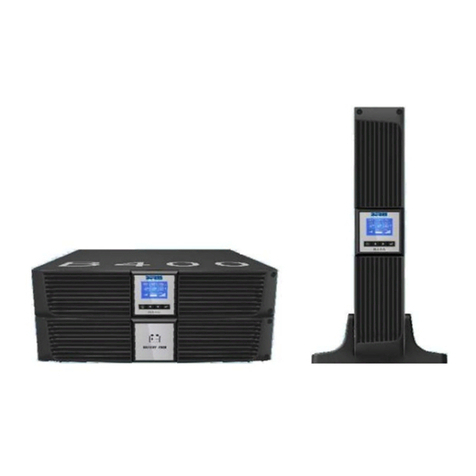
Borri
Borri B400R-010-B (C) user manual

Lince
Lince 1936-GCONT Installation, operation and maintenance manual

Vertiv
Vertiv Liebert GXT MT+ EX 1-3 kVA user manual
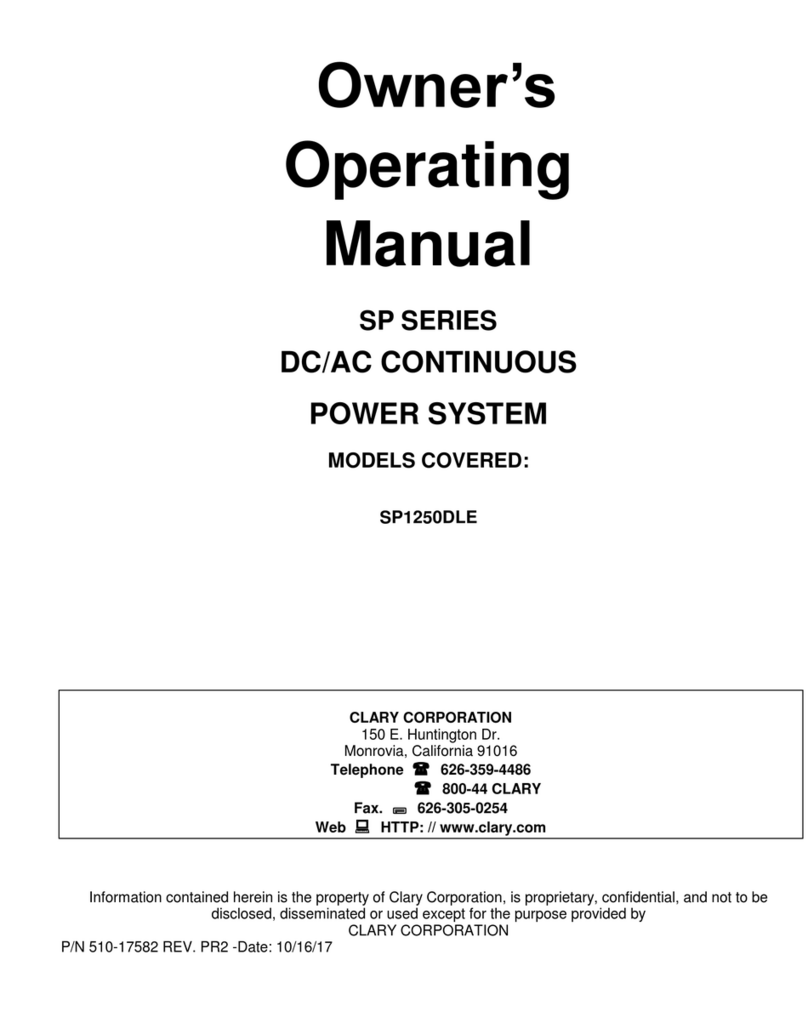
Clary Corporation
Clary Corporation SP1250DLE operating manual
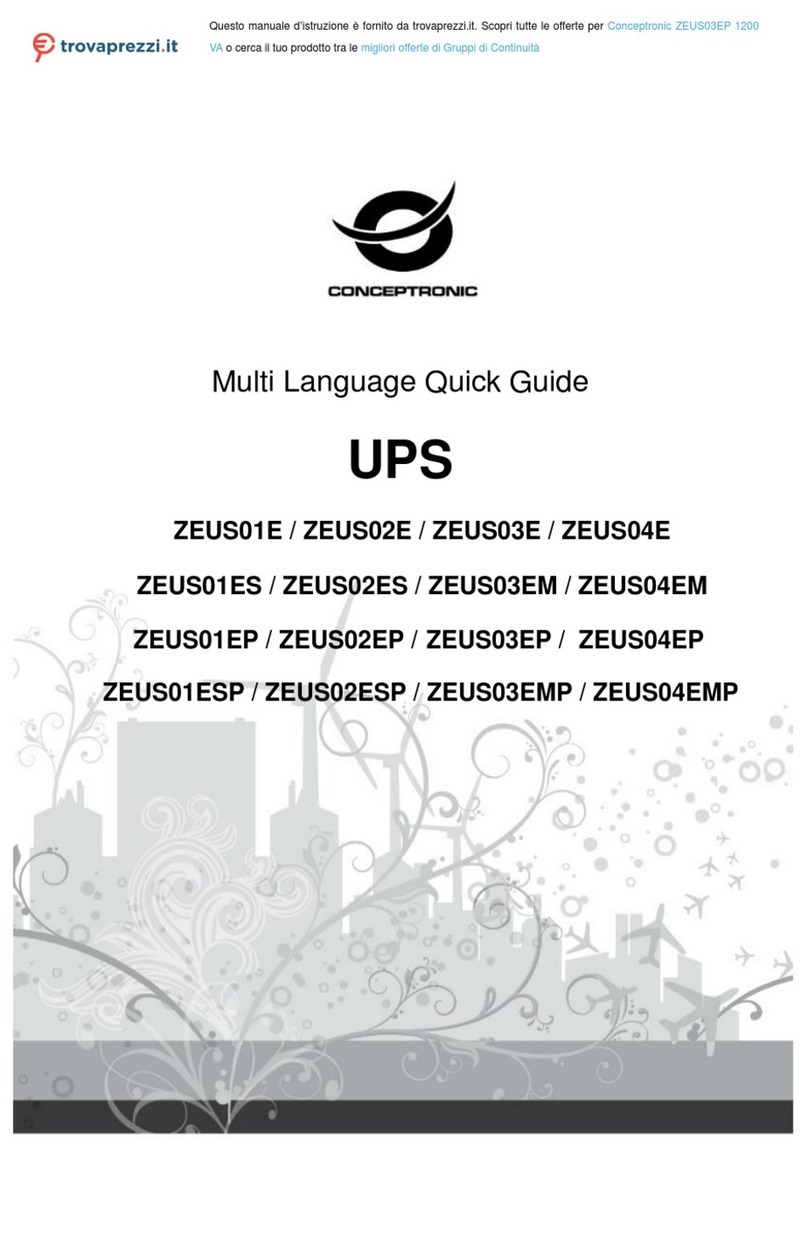
Conceptronic
Conceptronic ZEUS03EP Multi Language Quick Guide
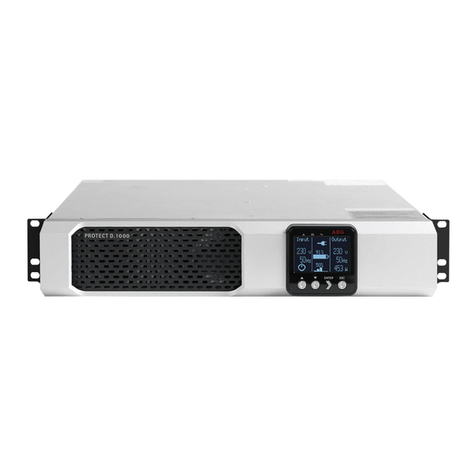
AEG
AEG protect d. 1000 operating instructions

Ditek
Ditek DTK-UPS400 user manual

Bicker Elektronik
Bicker Elektronik UPSI-1202 user manual
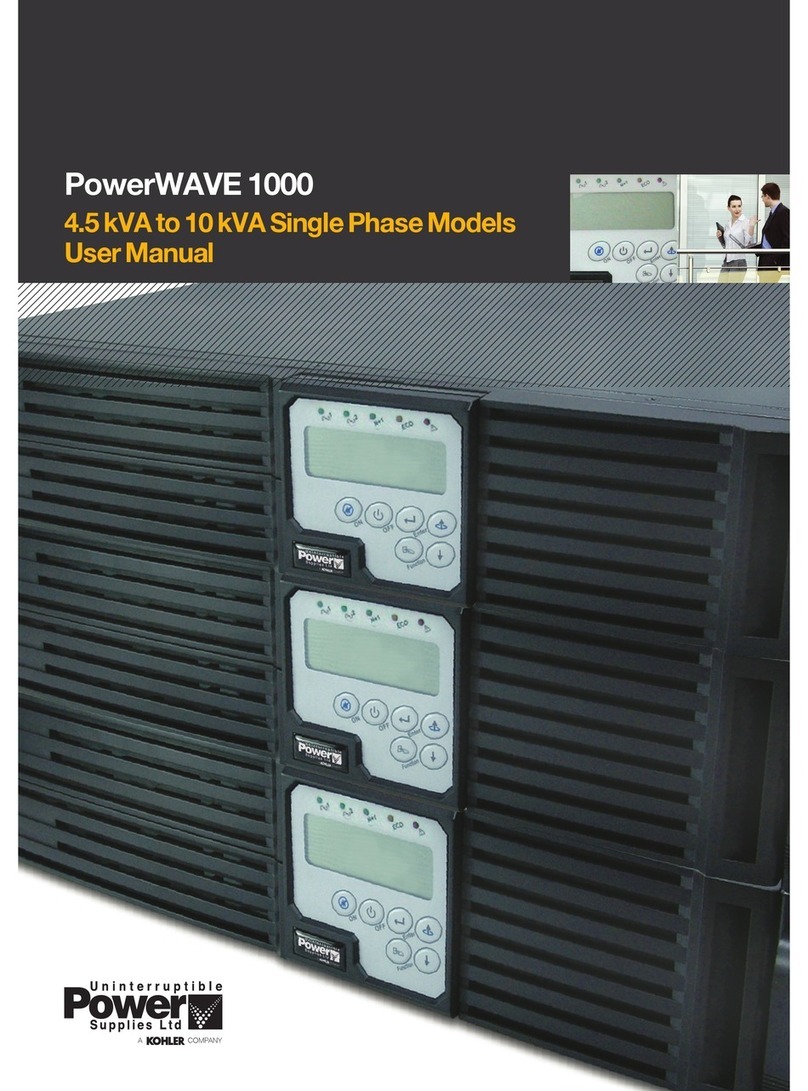
Uninterruptible Power Supplies
Uninterruptible Power Supplies PowerWAVE 1000 user manual

Vertiv
Vertiv Liebert ITA2 installation manual
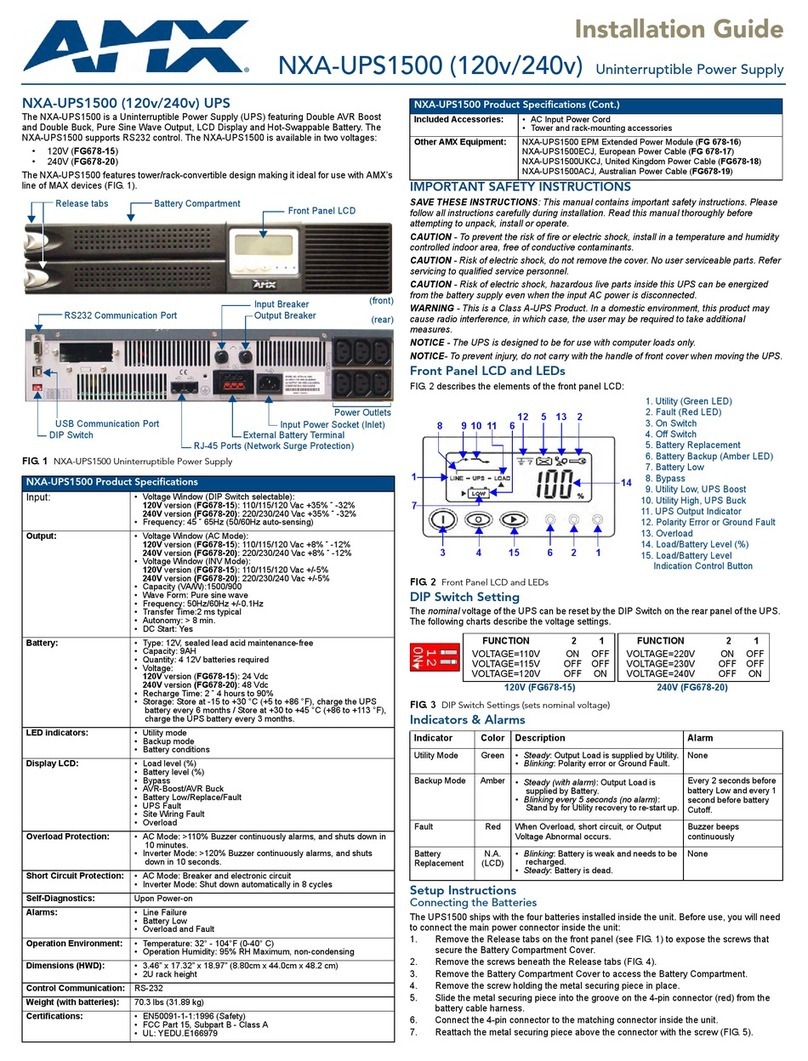
AMX
AMX NXA-UPS1500 installation guide
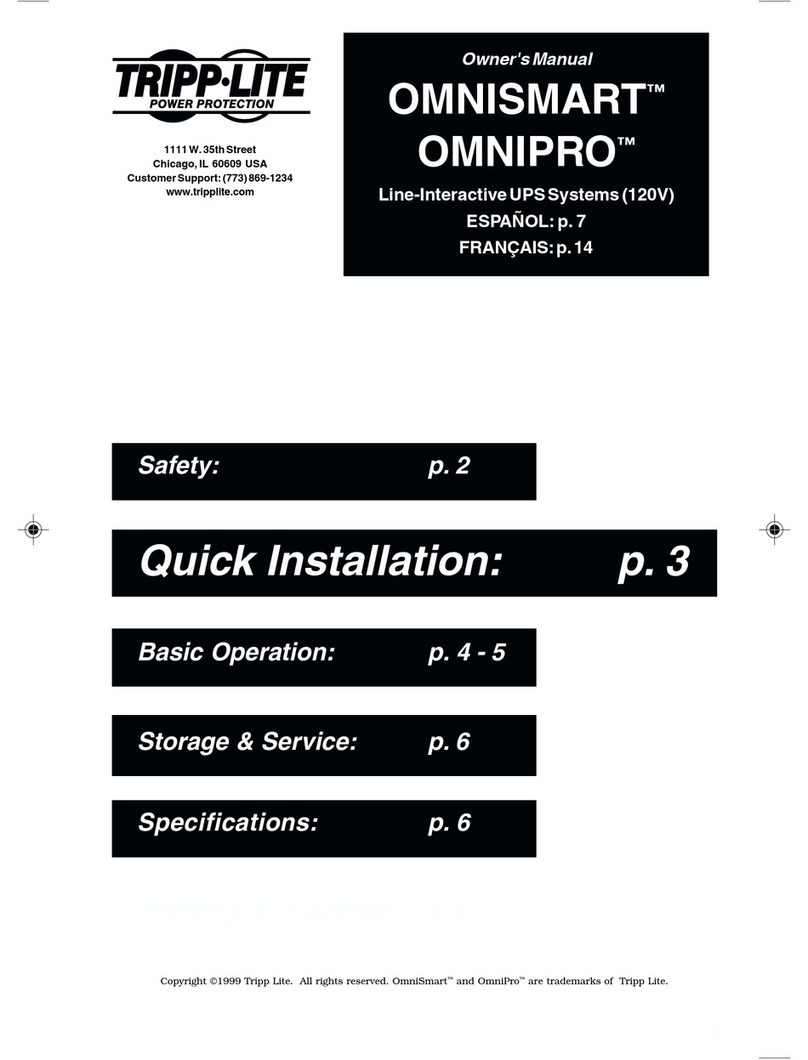
Tripp Lite
Tripp Lite OmniPro 675 owner's manual








